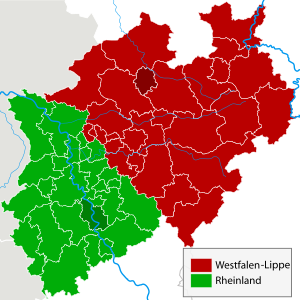Regional associations in North Rhine-Westphalia
The regional associations in North Rhine-Westphalia are institutions of local self-government in North Rhine-Westphalia . Alongside Lower Saxony , North Rhine-Westphalia is the only state in which landscape associations perform important public tasks. One also speaks of the two halves of the Rhineland and Westphalia-Lippe. Go back to the tasks of the former Prussian provinces Rhineland and Westphalia and, in a broader sense, the small state of Lippe.
organization
There are two regional associations in North Rhine-Westphalia. these are
- for the Rhenish part of the country the Landschaftsverband Rheinland (LVR) based in Cologne and
- for the Westphalian - Lippe part of the country, the Landschaftsverband Westfalen-Lippe (LWL) based in Münster .
However, the regional associations have no territorial sovereignty . Under constitutional law, the landscape associations are now considered part of local self-government . According to this concept, they are an association of regional authorities to fulfill tasks that go beyond the capabilities of the individual municipalities. Its legal basis is the North Rhine-Westphalia Regional Association Regulations. The highest body is the landscape assembly, which is formed by indirect election . It consists of delegated members of the district councils and the city councils in the case of independent cities. The composition of the assembly thus reflects the political majority in the districts (and thus in Westphalia-Lippe and Rhineland as a whole). The funding comes from a levy from the districts and independent cities , as well as grants from the state of North Rhine-Westphalia . Other organs are the director of the landscape association, who is neither a member nor chairman of the landscape assembly, and the landscape committee.
Extensive parts of the state property of the state of Lippe, which was dissolved in 1947, were transferred to the Landesverband Lippe . The Landesverband Lippe is a municipal association of the Lippe district and the local communities. In the Lippe part of the country he takes on similar tasks alongside the Regional Association of Westphalia-Lippe, in which the Lippe municipalities are fully involved.
The same applies to the regional association in the Ruhr Metropolis .
tasks
In the social area, the regional associations are responsible for supra-local social , disabled and youth welfare (e.g. state youth welfare office ) as well as for important social institutions, such as B. Specialized and especially psychiatric hospitals, special schools for disabled children. The tasks of the regional associations have always included the operation of (psychiatric) state hospitals, for example in Marsberg .
They are also responsible for the preservation of culture and monuments. A special feature in Germany is therefore the fact that in North Rhine-Westphalia there are two state curators and offices for monument preservation. The Rhenish Office for Monument Preservation is responsible for the area of the LVR and the LWL monument preservation, landscape and building culture in Westphalia for the area of the LWL . Former monuments and other possessions of the provinces have also remained in the possession of the landscape associations to this day. One example is the Kaiser Wilhelm Memorial at Porta Westfalica . The Regional Association of Westphalia-Lippe also operates 17 and the Regional Association of Rhineland 6 museums.
history
Today's regional associations go back to the provincial associations of the Prussian provinces of Rhineland ( Provincial Association of Rhineland ) and Westphalia ( Provincial Association of Westphalia ). The corresponding provincial parliaments were elected indirectly before 1920 and directly by the citizens from 1920 to 1933. They had certain powers in various areas and were part of the federal structure of the Weimar Republic . The provincial parliaments sent 13 of the 26 Prussian envoys with a free mandate to the Reichsrat (the forerunner of today's Bundesrat ). This and all other rights of the provinces were initially abolished with the law on the reconstruction of the Reich of January 30, 1934, with which the national socialists brought the state into line. When the state of North Rhine-Westphalia was founded by the British military government, the rights of the state representations were then transferred in a greatly reduced form to the Rhineland regional associations based in Cologne and Westphalia-Lippe in Münster.
In the course of the reform of the administrative districts, a reform of the landscape associations is also being discussed, but this is as controversial as the reform of the administrative districts. The discussion about reforming the middle administrative level is also taking place in North Rhine-Westphalia . The criticism of the two landscape associations went so far that the then Prime Minister Wolfgang Clement even proposed their dissolution (see also administrative districts in North Rhine-Westphalia ). Clement failed with this endeavor. The later government of Rüttger planned to convert the two landscape associations and five administrative districts into three regional districts, one each for the Ruhr area, Westphalia and the Rhineland. But these plans were not realized either.
See also
- Landscapes and landscape associations in Lower Saxony
- Landscape Assembly Rhineland
- Landscape Assembly Westphalia-Lippe
Web links
- Landscape Association Regulations North Rhine-Westphalia
- Website of the Regional Association of Westphalia-Lippe: www.lwl.org
- Website of the Rhineland Regional Association: www.lvr.de
Individual evidence
- ^ Coalition agreement of 2005 ( Memento of December 10, 2006 in the Internet Archive )
